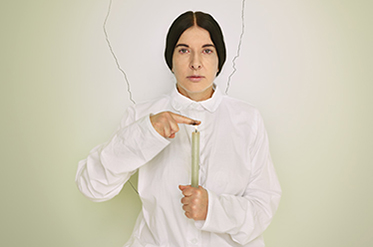 Among the many acts and events at this year’s Dark Mofo festival, currently showing in Tasmania, is the exhibition Private Archaeology by Serbian, New York-based performance artist, Marina Abramovic. Listed as one of Time Magazine’s most influential people of 2014, Abramovic is a pioneer of performance art, primarily when it comes to audience participation. Private Archaeology is Abramovic’s first show in Australia for 17 years.
Among the many acts and events at this year’s Dark Mofo festival, currently showing in Tasmania, is the exhibition Private Archaeology by Serbian, New York-based performance artist, Marina Abramovic. Listed as one of Time Magazine’s most influential people of 2014, Abramovic is a pioneer of performance art, primarily when it comes to audience participation. Private Archaeology is Abramovic’s first show in Australia for 17 years.
Strangely, as a collection of Abramovic’s works from 1975 to the present, it isn’t a retrospective. It should be viewed instead for what it is: a collection by MONA’s senior curators, Nicole Durling and Olivier Varenne, that demonstrates the warrior seeker spirit of Abramovic, developed over the last 40 years.
Abramovic is neither feminist nor political artist, believing the pain associated with endurance can be the door to self-knowledge. Walking with Abramovic through the many doorways Durling and Varenne have scattered throughout nine galleries in the basement of MONA – art collector David Walsh’s Museum of Old and New Art in Hobart, Tasmania – is anything but painful.
It provides the opportunity to partake in a personal excavation of Abramovic’s life, which not only reveals much about the artist – it forms a lasting sense of introspection for the spectator as well. For those who travel to see the exhibition – and people will (and should) flock from all over the country to see it – there will be a polarisation over the validity of some of this work.
Abramovic is a superstar, whether she pretends to like it or not, and spending a considerable amount of time in the exhibition engaging with the iconic image of the artist is not nearly as interesting as engaging with works where the artist is less present.
Literal images of Abramovic are pleasantly absent from The Chamber of Silence (2015), Gallery Six; At The Waterfall (2003), Gallery Seven; Transitory Objects (1989-2015), Gallery Eight; and Counting The Rice (2015), Gallery Nine. For me this allowed the work to stand on its own.
At The Waterfall is a sound and video avalanche of 108 separate male and female Buddhist monks captured over five years as Abramovic travelled alone throughout India. On first glance it would seem quiet, peaceful and contemplative; but it is a confronting and brutal affront to the senses – especially after the experience of The Chamber of Silence in Gallery Six, where viewers sit in deck chairs wearing noise cancelling headphones, looking out through a large window into the peace and tranquillity of the MONA grounds; a random bunny even trotted through the landscape on my viewings as if released on cue by a stagehand from the wings.
Transitory Objects is a collection of objects central to experiencing the Abramovic method, an obscure mode of performance-led self discovery, developed over the last 30 years as part of her solo work. In Transitory Objects the audience engages with meditative practices as part of the viewing experience. For my viewing this was enlivened by the presence of student performers from the Theatre program at the Tasmanian College of the Arts (of which I’m the current head of department) who demonstrated the various modes of participation with these objects of transition.
The objects are in fact many smaller works including: White/Red Dragon (1989/90), Inner Sky (1991 and 2015), and Chair for Human Use with Chair for Spirit Use (2012). Each Object is made from a variety of precious minerals, metals and timber. All have emerged in response to Abramovic’s experiences climbing and walking the Great Wall in China, where the materials used are those encountered along the way.
In this work Abramovic presents “tools for a method”. These transitory objects ask the viewer to physically touch, rest and sit on or against them, thereby literally becoming tools for meditative transformation.
In Gallery Nine we enter the MAI, the Marina Abramovic Institute, which “encourages participation and challenges modes of seeing the world”. On a 25-metre-long table – with all personal valuables secured in lockers, wearing monogrammed white lab coats and ear muffs – Abramovic’s training regime for a better humanity commences through the simplest task of counting grain in silence.
Counting the Rice asks the visitor to separate, count and record piles of rice and lentils in a search for stillness and peace. This work heralds a new focus for Abramovic, where “rules of participation” are now central to the viewing experience. Artist and work are inseparable, and for Abramovic, who doesn’t use a studio and makes through the act of living, her life literally is the work.
While I both understand and find this approach strangely attractive and admirable, it feels as if we’ve arrived at a point where Abramovic’s art and life now need to separate. I gained a truer sense of how the artist interacts with the world when able to read her work sans icon and brand. I think Abramovic would appreciate that.
Marina Abramovic, Private Archaeology curated by Nicole Durling and Olivier Varenne, is presented as part of Dark MOFO at MONA Tasmania, until 5 October. Details here.
Excavating Marina Abramovic’s Private Archaeology
Matt Delbridge is Head of Theatre, TCotA at University of Tasmania.
This article was originally published on The Conversation. Read the original article.
Image: Artist Portrait with a Candle (detail). © Marina Abramovic, Courtesy of the Marina Abramovic Archives
